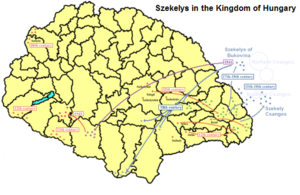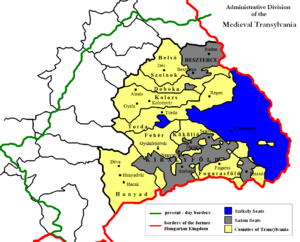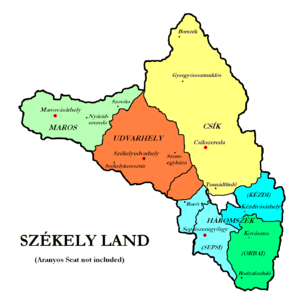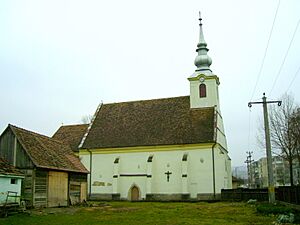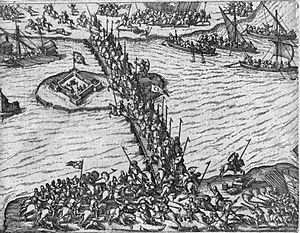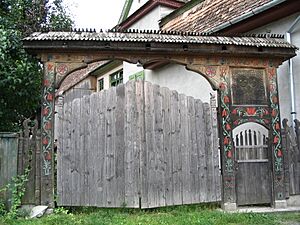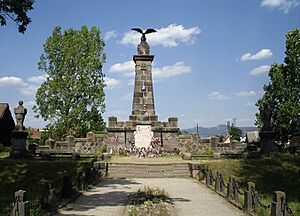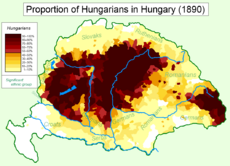History of the Székely people facts for kids
The Székely people are a special group of Hungarians living in Romania. Their story goes back a long way, at least to the 12th century. For a long time, people believed they were descendants of the ancient Huns. This idea came from old books written in the Middle Ages.
Today, most experts don't agree with the Hun theory. But there is no single idea about where the Székelys truly came from. They were known as brave warriors who fought at the front of the Hungarian army. This suggests they were a unique group. Even so, their language is Hungarian, with no signs of having changed from another language.
Székely warriors lived in small groups across the Kingdom of Hungary. They were especially found along the western borders until the 14th century. Their move to Transylvania started in the 11th or 12th century. They first settled in southern Transylvania. Later, they moved to what is now called Székely Land. This happened after the Transylvanian Saxons arrived in the late 12th century.
From the 1220s, a royal official called the Count of the Székelys oversaw them. Their important role in the army helped them keep their special rights. They did not have to pay taxes. Also, the kings of Hungary could not give away land in Székely Land. Their main local government units were called seats from the 14th century. These seats were led by elected officials. The Székelys became one of the "Three Nations of Transylvania". This happened after they formed an alliance with Hungarian noblemen and Saxon leaders in 1437. This alliance was against the peasants of Transylvania.
By the 15th century, three main groups existed within Székely society. The commoners, called pixidarii, owned small plots of land. They fought as foot soldiers. The wealthier primipili were mounted warriors. The high-ranking primores often owned large estates outside Székely Land. They started to gain more power over the commoners.
From the 1460s, royal judges oversaw the elected officials of the seats. These judges were appointed by the counts of the Székelys. By the 1550s, commoners who could not serve in the army lost their tax-free status. Many became serfs (like peasants tied to the land) after their rebellion was crushed in 1562. The power of the royal judges grew, which limited the seats' independence. However, the special rights of Székely towns were confirmed.
Most Székelys remained Roman Catholic. But in the 16th century, many became Calvinists, Unitarians, or Sabbatarians. Their special rights were given back in the 17th century. Yet, many commoners chose to become serfs to avoid military service. After Transylvania became part of the Habsburg monarchy in the 1690s, the government tried to limit Székely freedoms.
In 1764, a terrible event called the Siculicidium (Massacre of Székelys) happened at Madéfalva. After this, hundreds of villages became part of the Military Frontier. Thousands of Székelys moved to Moldavia to avoid serving in the army. The Székely border guards who stayed lived under strict military rules.
Contents
Where Did the Székelys Come From?
Old stories from the Middle Ages all said the Székelys came from the Huns. The Huns were a powerful group from the 5th century. Books like the Gesta Hungarorum and writings by Simon of Kéza first shared this idea. The Székelys themselves believed in their Hunnic origin. It's hard to know if this was a true old belief or if they adopted it from the medieval writers. Most modern historians today do not believe the Székelys are linked to the Huns.
Here are some old writings about the Székelys and Huns:
They, having set forth from the island, riding through the sand and flow of the Tisza, crossed at the harbour of Beuldu, and, riding on, they encamped beside the Kórógy river, and all the Székelys, who were previously the peoples of King Attila, having heard of Usubuu’s fame, came to make peace and of their own will gave their sons as hostages along with divers gifts and they undertook to fight in the vanguard of Usubuu’s army, and they forthwith sent the sons of the Székelys to Duke Árpád, and, together with the Székelys before them, began to ride against Menumorout.
These Székelys were the remains of the Huns, who when they learned that the Hungarians had returned to Pannonia for the second time, went to the returnees on the border of Ruthenia and conquered Pannonia together.
They were afraid of the western nations that they would suddenly attack them, so they went to Transylvania and did not call themselves Hungarians, but Székelys. The western clan hated the Huns in Attila's life. The Székelys are thus the remnants of the Huns, who remained in the mentioned field until the return of the other Hungarians. So when they knew that the Hungarians would return to Pannonia again, they hurried to Ruthenia to them, conquering the land of Pannonia together.
It is said that in addition to the Huns who escorted Csaba, from the same nation, three thousand more people retreating, cut themselves out of the said battle, remained in Pannonia, and first established themself in a camp called Csigla's Field. They were afraid of the Western nations which they harassed in Attila's life, and they marched to Transylvania, the frontier of the Pannonian landscape, and they did not call themselves Huns or Hungarians, but Siculus, in their own word Székelys, so that they would not know that they are the remnants of the Huns or Hungarians. In our time, no one doubts, that the Székelys are the remnants of the Huns who first came to Pannonia, and because their people do not seem to have been mixed with foreign blood since then, they are also more strict in their morals, they also differ from other Hungarians in the division of lands. They have not yet forgotten the Scythian letters, and these are not inked on paper, but engraved on sticks skillfully, in the way of the carving. They later grew into not insignificant people, and when the Hungarians came to Pannonia again from Scythia, they went to Ruthenia in front of them with great joy, as soon as the news of their coming came to them. When the Hungarians took possession of Pannonia again, at the division of the country, with the consent of the Hungarians, these Székelys were given the part of the country that they had already chosen as their place of residence.
After the Hun theory lost favor in the 20th century, two main ideas about Székely origins appeared. Bálint Hóman suggested the Székelys were a Turkic group. He thought they joined the Magyars (Hungarians) in the Pontic steppes. György Györffy also believed the Székelys were a separate group. This was because they fought at the front of the Hungarian army. Györffy and Gyula Kristó linked the Székelys to the Eskils. The Eskils were a tribe in Volga Bulgaria in the 9th century. Kristó thought the Eskils were one of the three Kabars tribes. These Kabars joined the Magyars after leaving the Khazar Empire. However, linguists like Gyula Németh disagreed. They said the names "Székely" and "Eskil" are not related.
Most linguists and historians agree that the Székelys did not change their language. They speak Hungarian with no signs of a Turkic influence. Linguist Lóránd Benkő said that Székely dialects are very similar to Hungarian dialects spoken near the borders of the medieval Kingdom of Hungary. He suggested the Székelys came from military guards who protected the borders. Their military role gave them special rights. This helped them develop their own unique identity. Gyula László and Pál Engel thought the Székelys came from the "Late Avar" people. These people (also called Onogurs) supposedly spoke Hungarian and lived in the Carpathian Basin. The "Double Conquest Theory" of the Carpathian Basin by the Hungarians is not widely accepted.
Székelys in the Kingdom of Hungary
Early Settlements and Migrations
Old royal documents show that Székely groups lived in many parts of the Kingdom of Hungary. For example, a document from 1217 mentioned a military unit called "Székelyszáz hundred" in Bihar County. In 1256, a document spoke of a forest near Boleráz in Pozsony County (now in Slovakia) "towards the Székelys". Székely warriors from Nagyváty in Baranya County were mentioned in 1272. A royal document from 1314 said Székelys had lived in an estate in Sopron County long before. The Székelys of Sásvár in Ugocsa County (now Trosnik in Ukraine) were mentioned in 1323.
The three main dialects of the Székely language suggest their ancestors lived along the western borders. Székelys living near the rivers Nyárád and Kis-Küküllő (in Romania) speak a dialect similar to Hungarians near Pressburg (now Bratislava, Slovakia). The dialect of Udvarhelyszék is like the Hungarian spoken in Burgenland (now in Austria). The third Székely Land dialect is similar to the Hungarian dialect of Baranya County.
In 1116, Székely and Pecheneg warriors fought together in the army of Stephen II of Hungary. This was at the Battle of Olšava, according to the 14th-century Illuminated Chronicle. The chronicle blamed the Székelys and Pechenegs for the king's defeat. It called them "wretched poltroons" for retreating. Györffy believes their retreat was a feigned retreat, a common nomadic military trick. The same book said the "wretched" Pechenegs and "worthless" Székelys "as usual went before the Hungarian army" in the Battle of the Fischa in 1146. This shows they fought at the front. The negative words suggest the Székelys were lightly armored archers.
The Székelys were divided into six "kindreds". Each "kindred" had four "lineages". All kindreds were found in every district of Székely Land. This means the kindreds existed before the Székelys settled there. The names of two kindreds and five lineages came from Christian names.
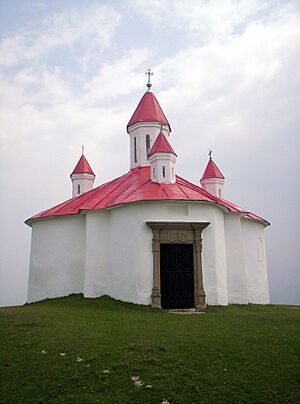
We don't know the exact date the Székelys settled in Transylvania. Simon of Kéza wrote that the Székelys "acquired part of the country ... not in the plains of Pannonia but in the mountains, which they shared with the Vlachs, mingling with them, it is said". Gyula Kristó says their move was due to more fighting along the eastern borders. Skirmishes along the western border became rare in the 12th century. Pál Engel, Zoltán Kordé and Tudor Sălăgean believe the kings of Hungary settled the Székelys in Transylvania in stages. Kristó adds that some Székely border guards moved to Transylvania on their own. This was because the breakdown of border counties threatened their freedom.
The first groups likely settled in southern Transylvania. They were along the rivers Kézd, Orbó, and Sebes (in Romania). Three administrative units in Székely Land were named after these rivers: Kézdiszék, Orbaiszék and Sepsiszék. Cemeteries from the early 12th century found at Szászsebes and Homoróddaróc (in Romania) show the area was lived in before the Transylvanian Saxons arrived. Székelys from Telegd in Bihar County (now Tileagd in Romania) also moved to Transylvania. A group of Székelys was known as the Székelys of Telegd in the 13th century.
Around 1210, Joachim, Count of Hermannstadt, led an army. It included Saxons, Vlachs, Székelys, and Pechenegs. They crossed the Carpathian Mountains to fight for Boril of Bulgaria. This is according to a royal document from 1250. This record suggests these four groups were under the Counts of Hermannstadt in the early 13th century.
In 1213, William, Bishop of Transylvania, gave the tithe (a tax) in Burzenland to the Teutonic Knights. But he kept the right to collect tithes from Székelys (and Hungarians) who would settle there. This shows many Székely groups were moving in the early 13th century. The "land of the Székelys" was north and northeast of the Knights' land in 1222. Two years later, King Andrew II gave the land of the Székelys of Sebes to the Transylvanian Saxons. This united the Saxon territories in southern Transylvania under the Count of Hermannstadt.
More than a dozen place names of Slavic origin suggest that Slavic-speaking people lived in Székely Land when the Székelys arrived. Also, many old Hungarian place names (personal names) imply other Hungarian-speaking groups were there before the Székelys. The same is true for the parts of Fehér County that remained within Székely Land until the 19th century.
Székely Privileges and Society
In the early 13th century, the Székelys were placed under a new royal official. This was the Count of the Székelys. The first known count, Bogomer, son of Szoboszló, was captured in 1228. This happened during a campaign by Béla, Duke of Transylvania, against Bulgaria. The kings always chose Hungarian noblemen to be counts. The main administrative units of Székely Land were first called "terra" (or land). The Diploma Andreanum first mentioned such a territory in 1224. It spoke of terra Sebes ("the land of the Székelys of Sebes").
The Mongol invasion of the Kingdom of Hungary caused less damage in Székely Land than elsewhere in Hungary. Just two years after the Mongols left, Székely troops joined Lawrence, Voivode of Transylvania, in a campaign. This was in the Principality of Halych-Volhynia. Székely warriors fought in the royal army against the Czechs and Austrians in the Battle of Kressenbrunn in 1260. Stephen V of Hungary gave royal lands along the Aranyos River (now Arieș in Romania) to the Székelys of Kézd. They built 18 villages there in two decades. The Mongols invaded Hungary again in 1285. The Székelys, Vlachs, and Saxons fought them at the border. They stopped a sudden attack. The Székelys of Aranyos successfully defended Torockó (now Rimetea in Romania). They forced the invaders to release hundreds of captives.
The Székelys did not get a royal document listing all their freedoms. But royal papers show they had a special legal status. They were not under the power of the voivodes or the ispáns (heads) of the counties. Their land could not be taken by the king. Also, kings could not give away land in Székely Land. King Béla IV wanted to reward a count named Vincent in 1252. He gave him land in Fehér County (outside Székely Land). Vincent was likely the head of a Székely kindred. Four families from him became top officials in Sepsiszék for centuries. In 1324, the Székelys stopped two noblemen from taking land in Csík. King Charles I of Hungary had given this land (Lok) to them.
Most land in Székely Land was owned by the community, not individuals. In the early 1270s, Stephen V of Hungary had to tell the community of the Székelys of Telegd to accept two men into their society. This allowed them to hold their estates "without borders, like the Székelys". Parts of the communal lands were sometimes divided by "drawing arrows". Communal property got smaller as forests were cut down and marshlands drained. This was because individuals who improved the land claimed it. The Székelys did not pay taxes. But landowners in Székely Land had to serve in the royal army. Daughters could only inherit land if they had no brothers. A daughter who inherited land (called a "boy-daughter") had to provide a warrior to fight for her. The Székelys gave 80 horses to Ladislaus IV of Hungary in the late 13th century. Later, each Székely household had to give an ox to the king when he married or when his first son was born.
The Székelys' group rights grew stronger in the 1290s. Their representatives attended the general assembly held by Andrew III of Hungary at Gyulafehérvár (now Alba Iulia in Romania) in 1291. Ehelleus Ákos, Vice-Voivode of Transylvania, gave the fortress on Székelykő at Torockó (now Piatra Secuiului in Romania) to the Székelys of Aranyos. The Székelys also had representatives at the Diet of Hungary in Pest in 1298.
Ladislaus III Kán took control of Transylvania in the 1290s. He used the weakening of royal power to do this. In 1296, he held a general assembly near Torda (now Turda in Romania). The head of the Székelys of Aranyos was there. However, the Székelys did not support his sons' rebellion against Charles I of Hungary in the late 1310s.
Later Medieval Period
The papal tithe register from 1330 to 1337 gives the first detailed information about Roman Catholic parishes in Székely Land. At least 150 parishes were mentioned. This shows that a church was built in at least 80% of the villages. This was much higher than other parts of the kingdom (under 40%). The parishes were divided among four archdeaneries of the Roman Catholic Diocese of Transylvania. There is no evidence of Orthodox communities during this time.
The Székely administrative units were called széks (or seats) from the mid-14th century. There were seven seats at first. But Stibor of Stiboricz, Voivode of Transylvania, allowed the community of Miklósvár (now Micloșoara in Romania) to set up its own court around 1395. The other seats only recognized Miklósvárszék in 1459. Each seat was led by two elected officials: the lieutenant (maior exercitus) and the seat judge (iudex terrestris). Lieutenants were supposed to handle military matters. Seat judges handled legal issues. But lieutenants also heard legal disputes. Both officials heard cases with twelve jurors.
Only Székelys who owned land called "Székely inheritance" could be elected. This land almost always included a mill, which increased the owner's income. "Székely inheritances" were divided among the lineages. The right to choose officials for a seat moved from one lineage to another each year. So, families with more than one "Székely inheritance" held offices more often.
Most Székely villages were named after a lineage or individuals. These names are known from 13th and 14th-century documents. Unlike villages in the counties, Székely villages kept their independence. Ten families formed the basic administrative units (called "tenths") of Székely Land. Tenths oversaw the regular division of communal lands.
Tenths were also in charge of gathering Székely warriors for battle. The Székelys' military duties did not lessen in the 14th century. Andrew Lackfi, Count of the Székelys, led a campaign against the Golden Horde in 1345. His victory helped Hungary expand across the Carpathian Mountains. It also helped establish Moldavia. Székely troops also fought in the campaigns of Louis I of Hungary in Italy, Lithuania, Serbia, and Bulgaria. Stephen Kanizsai led Székely warriors in the Battle of Nicopolis in 1396. This battle ended with a huge defeat for the Christian army by the Ottomans.
In the late 15th century, Székelys mainly grew grain, onion, cabbage, hops, hemp, and flax. Apple, pear, plum, walnut, and hazelnut were common fruits. Raising horses and cattle was also important for the local economy. The Székelys also traded furs from wolves, foxes, squirrels, and other wild animals. The staple right of the Saxon town of Brassó (now Brașov in Romania) hurt the growth of nearby Székely towns. This was especially true for Sepsiszentgyörgy (now Sfântu Gheorghe in Romania). A royal document from 1427 recorded a town in each seat. But most towns only received special rights in the next century.
The existence of different legal groups within Székely society was first recorded in the early 15th century. But these three main groups likely started much earlier. Archaeologist Elek Benkő suggests the three-part Székely community (high-ranking primores and primipili, and commoners) kept features of 11th-century Hungarian society. The number of Székelys who struggled to make a living grew in the 15th century. This was due to land being divided through inheritance. The poor worked for wealthy landowners. On the other hand, Székelys who fought in wars could receive land outside Székely Land. Hungarian noblemen could gain "Székely inheritance" through marriage or buying it. So, the wealthiest landowners held offices in both the seats and the counties. Since their lands in the counties were worked by dependent peasants, they also wanted to reduce the freedom of commoners working on their Székely Land estates.
In spring 1437, Hungarian and Vlach peasants rebelled in Transylvanian counties. Roland Lépes, Vice-Voivode of Transylvania, asked the Székelys and Saxons for help. Representatives from the counties and the Székely and Saxon seats met at Bábolna (now Bobâlna in Romania). On September 16, they signed a "brotherly union". They promised to help each other against everyone except the king. After their combined army defeated the peasants, they confirmed their alliance on February 2, 1438. This led to the idea of the "Three Nations of Transylvania".
Ottoman raiders often attacked Transylvania from the early 15th century. In 1421, Ottoman raiders defeated an army of Székelys and Saxons at Brassó (now Brașov in Romania). In 1432, Ottoman, Wallachian, and Moldavian troops attacked Székely Land. Ottomans broke into Székely Land again in 1438. Sigismund, King of Hungary, had already ordered in 1419 that a third of Transylvanian noblemen and a tenth of peasants had to fight if the Ottomans invaded. This was to help the Székelys and Saxons defend the borders. The churches in Székely Land showed a "frontier-guard mentality". Churches in Csíkszék were fortified in the 15th century. Paintings on many church walls showed King St Ladislaus's legendary fight with a "Cuman" warrior. Stories from the life of Saint Margaret of Antioch were also painted on at least 8 churches. Most paintings were in a Byzantine style. The first mentions of Székely primary schools were recorded in the 15th century. A schoolmaster lived in Hídvég (now Hăghig in Romania), and a teacher in Előpatak (now Vâlcele) in 1419.
To ensure unified command of the borders, Vladislaus I of Hungary made John Hunyadi, Ban of Szörény, and Nicholas Újlaki, Ban of Macsó, joint leaders. They became voivodes of Transylvania and counts of the Székelys in 1441. Székely warriors went with Hunyadi during his campaigns in the Balkan Peninsula. Hunyadi ordered Nicholas Vízaknai, Vice-Voivode of Transylvania, and John Geréb of Vingárt, Castellan of Görgény (now Gurghiu in Romania), to hold an assembly. In 1451, 24 Székely jurors met in Marosvásárhely to write down customary laws. This first known Székely lawmaking assembly decided that those who owned land for 32 years gained full ownership.
Hunyadi's son, Matthias Corvinus, became king in 1458. In 1462, he confirmed the right of the Székelys of Kászon to freely elect a lieutenant and a seat judge. The jobs of voivode of Transylvania and count of the Székelys were combined in the 1460s. After that, kings always appointed the same noblemen to both roles. To keep the Székely community strong militarily, Matthias ordered the collection of commoners' freedoms in 1466. The joint assembly of Transylvanian noblemen and Székely elders declared that a Székely could not be forced to work on a landowner's estate. The assembly also ruled that two-thirds of the jurors had to be elected from commoners. After this, the counts of the Székelys appointed a "royal judge" (or iudex regius) to oversee justice in each seat.
However, poor Székely commoners could not fight as mounted warriors. This forced Matthias to change his plan. In 1473, he issued a new rule. It separated the military duties of the three main Székely groups. The primores, who owned estates of at least three "bowshots" in size, had to provide three mounted warriors. The primipili, with estates of two "bowshots", continued to fight as mounted soldiers themselves. The Székely commoners, or pixidarii, only had to fight as foot-soldiers.
Stephen Báthory, Voivode of Transylvania and Count of the Székelys, tried to reduce the seats' independence in the early 1490s. He accused many primores of treason. He took their lands and forced Székely heiresses to marry his followers. The Székelys demanded that Vladislaus II of Hungary replace Báthory. In 1493, he did, with Bartholomew Drágffy and Stephen Losonczy. But Drágffy, Losonczy, and those who came after them neglected justice. János Bögözi, Lieutenant of Udvarhelyszék, called a general assembly. In 1505, they set up an appellate court.
The Székelys' sense of identity grew stronger after their link to the Huns was printed in books in the late 15th century. They saw themselves as embodying the Huns' military virtues. They began to demand recognition of their special status. King Vladislaus II's only son, Louis, was born on July 1, 1506. Royal officials came to Székely Land to collect oxen. Traditionally, these were given to kings on such occasions. But the custom had been forgotten, as kings had not had sons for a century. The Székelys said they were noblemen (who didn't pay taxes). They refused to give oxen to the royal officials. The royal army commander, Pál Tomori, could only stop the riot with help from Saxon troops. András Lázár called a new general assembly at Agyagfalva (now Lutiţa in Romania). It banished those who had plotted against the king and took their land.
The leader of the great Hungarian peasant uprising in 1514, György Dózsa, was of Székely origin. But the Székely commoners did not support the rebels. John Zápolya, who had been count of the Székelys since 1510, played a key role in the noblemen's victory over the peasants. He also put down a revolt by Székely commoners in 1519. He ignored the special status of land in Székely Land. He took the rioters' lands for the royal treasury.
Changes and Challenges
The Ottoman Sultan, Suleiman the Magnificent, heavily defeated the Hungarian army in the Battle of Mohács on August 29, 1526. King Louis II of Hungary died in the battle. So, John Zápolya and Ferdinand of Habsburg both claimed the Hungarian throne. Both were elected kings before the end of the year. The Székelys supported John. After he allied with the Ottomans, the sultan told Petru Rareș, Voivode of Moldavia, to invade Transylvania. This was to fight Ferdinand's local supporters in 1529.
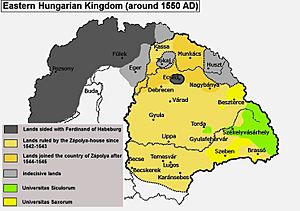
In 1538, John agreed that Ferdinand could unite Hungary after John's death. However, after John died in 1540, his supporters declared his baby son, John Sigismund, king. The new civil war allowed Suleiman to take central Hungary. But he let John Sigismund keep the lands east of the Tisza River. The young king and his mother, Isabella Jagiellon, settled in Transylvania in 1542.
Johannes Honter, a Lutheran priest from Brassó, sent preachers to Székely Land in the 1540s. The wealthy Pál Daczó was the first Székely to definitely become Lutheran. He renovated the old church of Sepsiszentgyörgy (now Sfântu Gheorghe in Romania) in 1547. Most villages in Miklósvárszék were Lutheran by the early 1550s. But most Székelys remained Roman Catholic. The Reformation also helped education grow. New schools opened in many places, including Székelykál and Gidófalva (now Căluşeri and Ghidfalău in Romania). The high schools at Marosvásárhely and Székelyudvarhely became the first secondary schools.
Isabella gave up her son's kingdom to Ferdinand of Habsburg in 1551. Ferdinand made István Dobó and Ferenc Kendi voivodes of Transylvania. These two leaders confirmed the Székelys' special rights in 1555. John Sigismund and his mother returned to Transylvania in 1556. In the following years, the Diet (assembly) passed laws limiting Székely freedoms. In 1557, the king could take the land of Székelys found guilty of treason. A year later, the Székely community had to pay a large tax of 5,000 florins. Only the primores and primipili from notable 15th-century families were exempt. However, the queen said Székely towns only had to contribute to the yearly tribute paid to the sultans. The towns were also free from the seats' authority.
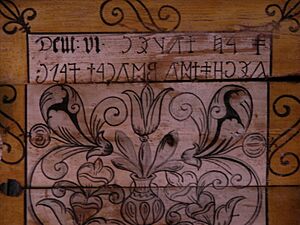
After Melchior Balassa rebelled against John Sigismund, the primipili met at Székelyudvarhely in April 1562. Thousands of commoners joined them. They demanded punishment for wealthy Székelys. They accused them of illegal tax collection and predatory lending (charging very high interest). The commoners attacked manors and defeated a royal army. However, their army broke up easily after John Sigismund defeated a small group. The Diet passed laws on June 20, 1562, to limit commoners' freedom. The Székely Land court of appeal was closed. Commoners lost their right to be elected as jurors. Royal judges became the only leaders of the seats. Two royal castles, Székelytámad ("Székely-assault") and Székelybánja ("Székely-regret"), were built in Székely Land. Székely commoners were no longer required to fight in the royal army. This took away the legal basis for their freedom. They were seen as the king's serfs. Many were forced to work building royal castles or in salt mines. John Sigismund gave hundreds of Székely serfs to his supporters after 1566.
Hungarian-speaking preachers spread the ideas of John Calvin from the late 1550s. The synod (church meeting) of Marosvásárhely accepted Calvin's views of the Eucharist in 1559. This was the first church assembly document recorded in Hungarian. In 1568, the Diet declared that all preachers could preach "according to his own understanding". This helped spread Anti-Trinitarian ideas. Most Székely villages remained Roman Catholic. But some Calvinist settlements joined the new Unitarian Church of Transylvania.
Székelys in the Principality of Transylvania
Under Ottoman Influence
John Sigismund called himself "prince of Transylvania" after the Treaty of Speyer in 1570. Soon after he died, armed Székely commoners marched to Gyulafehérvár. They demanded their freedom back from his successor, Stephen Báthory. When Báthory refused, hundreds of Székelys joined his opponent, Gáspár Bekes. After Báthory defeated Bekes in 1575, over 60 Székelys were executed. Báthory's supporters received Székely serfs.
Anti-Trinitarian preachers, who did not believe in the Trinity, appeared in Székely Land in the late 1570s. They discouraged worshipping Jesus. People started interpreting the Bible for themselves in the 1580s. The idea of social equality in the Old Testament matched Székely traditions. This helped spread "Judaizing" views among the Székelys. András Eőssi was the first leader of the Szekler Sabbatarians. In 1595, the Diet ordered the persecution of radical Protestants. Benedek Mindszenti, Captain of Udvarhelyszék, forced hundreds of Sabbatarians to leave Transylvania.
Stephen Báthory's successor, Sigismund Báthory, joined the Holy League. This league was formed by Pope Clement VIII against the Ottoman Empire. Sigismund promised to restore the Székelys' freedoms if they fought the Ottomans. More than 20,000 Székelys joined the army. The combined forces of Transylvania, Wallachia, and Moldavia defeated the Ottomans in the Battle of Giurgiu. Even though the Székely serfs helped win, the landowners refused to free them. Sigismund also broke his promise. So, the serfs rebelled. Stephen Bocskai brutally crushed the revolt during the "Bloody Carnival" of 1596.
Sigismund gave up his rule to his cousin, Andrew Báthory, in March 1599. Andrew's friendly policy towards the Ottomans threatened Michael the Brave, Voivode of Wallachia. Michael decided to invade Transylvania. The Holy Roman Emperor, Rudolph II, who also wanted Transylvania, supported him. Michael showed a fake document saying Rudolph would free the Székely serfs. Thousands of Székelys joined Michael's army. But many Székely noblemen stayed loyal to Andrew. Andrew was killed by Székely peasants after Michael's victory in the Battle of Sellenberk. Michael the Brave gave the Székely commoners their freedom back. They took revenge for the Bloody Carnival.
Transylvania fell into chaos in the following years. Rudolph's general, Giorgio Basta, drove Michael out of Transylvania. He also took away the Székelys' freedoms. Moses Székely (the only prince of Székely origin) rebelled against Basta in 1603. Most Székelys from Udvarhelyszék, Marosszék, and Aranyosszék supported him. But most Székelys from other seats joined his opponent, Radu Șerban, Voivode of Wallachia. János Petki, Captain of Udvarhelyszék, called a general assembly of the Székelys. This was shortly after Stephen Bocskai rebelled against Rudolph in October 1604. The Székely noblemen and commoners all agreed to support Bocskai. They wanted him to confirm their freedoms and grant a general pardon for crimes during the chaos. Bocskai confirmed the Székelys' freedoms in a document on February 16, 1606. Five days later, delegates from the counties and the Székelys declared him prince.
Restoring Székely freedoms meant Székely serfs were free from regular taxes. Since serfs did not serve in the royal army, many Székely commoners chose to work for wealthier landowners. About 44% of Székelys were serfs in 1614. Most serfs in Marosszék said they chose serfdom voluntarily. This was to avoid poverty, hunger, and military service.
The detailed memoire of the Székely nobleman, Ferenc Mikó, is an important source for Transylvanian history from 1594 to 1613. The growth of large estates changed Székely society. Over a hundred peasants worked on the lands of the richest landowners. They renovated old castles or built new ones. They made them stronger with walls and towers in the 17th century. Smaller noblemen's homes were often decorated with wooden "Székely gates".
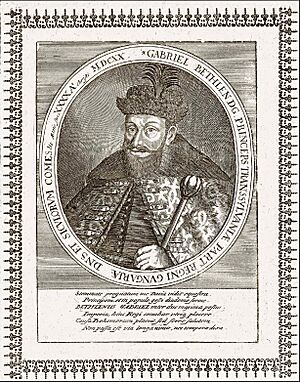
Landowners invited new people to settle on their lands. The 1614 census mentioned peasants named "Oláh" (or Vlach). They came from Moldavia, Wallachia, or the regions of Fogaras and Karánsebes (now Făgăraș and Caransebeș in Romania). The presence of new settlers and serfs in Székely villages required new rules for sharing communal lands. For example, the community of Udvarfalva (now Curteni in Romania) allowed two serfs to take parts of communal lands. But they had to leave if they had problems with the community. Villages also regulated the use of streams and rivers. They limited tanning, dyeing, and other activities that could pollute the water. The fast rivers' water power was also used. The Ottoman traveler, Evliya Çelebi, saw hundreds of sawmills in Székelyudvarhely. The mineral waters of Székely Land were famous throughout the principality.
Gabriel Bethlen was the first prince to see that fewer free Székelys meant a weaker Transylvanian army. He stopped Székelys from choosing serfdom. He ordered hundreds of serfs to be freed. He also ended the Székely serfs' tax exemption. This last rule made many serfs leave Székely Land. The freeing of Székely serfs continued under George I Rákóczi. He also gave land to the freed Székelys. Rákóczi gave up the king's right to take and give away land in Székely Land in 1636. Since the Sabbatarians supported Rákóczi's opponent, Moses Székely, the Diet ordered them to convert to one of the four official religions in 1638. Anyone who kept celebrating the Sabbath on Saturday and didn't baptize their children was imprisoned. Small Sabbatarian communities survived in the villages.
George II Rákóczi invaded Poland in 1656 without the sultan's permission. This led to the Ottomans invading Transylvania. István Petki, Captain General of Csíkszék, did not accept the sultan's offer to become prince himself. So, the Crimean Tatars looted Székely Land in 1661. Michael I Apafi, who was elected prince by the Ottomans, recruited Székelys to defend his palace and fortresses. He joined the Holy League against the Ottomans. He recognized that Transylvania was a land of the Holy Crown of Hungary in 1686.
Military Rule and Uprising
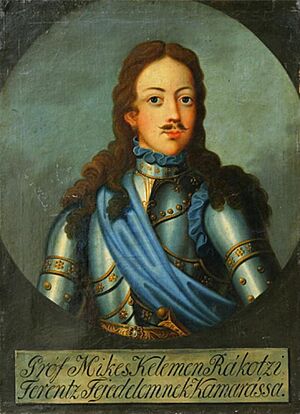
The army of Emperor Leopold I took over Transylvania in late 1687. He brought back civil government in 1690. He issued the Diploma Leopoldinum, which confirmed the special rights of the Three Nations. However, five years later, the imperial army occupied the principality again. The new government raised taxes and strengthened the Roman Catholic Church. This made people unhappy. The tax increases especially bothered Székely villages. But the imperial army commander, Jean-Louis Rabutin de Bussy, stopped all riots. He imprisoned many Székelys.
Francis II Rákóczi (a descendant of the Rákóczi princes of Transylvania) became the leader against Leopold. In autumn 1703, he took control of Upper Hungary (now Slovakia) and large areas east of the Tisza River. He sent letters to the Three Nations (and Romanians). He urged them to support his fight for independence. The Székelys of Háromszék and Csíkszék were among the first to join him. Rákóczi's supporters controlled Székely Land by early 1704.
The Diet declared Rákóczi prince. But he could not enter Transylvania after the imperial army defeated his supporters. This was at the Battle of Zsibó on November 11, 1705. Székely Land was put under military rule. Hundreds of Székelys left the principality. The authorities limited free movement and started collecting all weapons. Székely soldiers returned under Lőrinc Pekry in summer 1706. Rákóczi, elected prince again, confirmed the Székelys' rights in 1707.
Leopold's successor, Joseph I, promised a general pardon to those who surrendered. Rákóczi left Hungary for Poland to seek help. The rebels' representatives signed the Treaty of Szatmár in 1711. They accepted the rule of the Habsburgs. The Székely Kelemen Mikes was one of the few noblemen who followed Rákóczi into exile. Mikes's Letters from Turkey show his education in France and his Transylvanian background.
Towards Centralized Rule
After the Treaty of Szatmár, Transylvania became more integrated into the Habsburg monarchy. The Gubernium, a governing body of 12 members appointed by the monarchs, became the highest administrative power. But the most important decisions were made in Vienna. The Diet approved the Gubernium's decisions without question. The command of imperial and local troops was combined in 1713. Appeals against seat court decisions were heard at the Royal Table. Since the monarchs supported the Counter-Reformation, many Székely noble families converted to Catholicism. Unitarians and Sabbatarians faced strong persecution in the 1720s. The Diet was last called in 1761.
About 20% of Transylvania's population died from a plague between 1717 and 1720. Serfs continued to move to Moldavia and Wallachia. But most returned to Transylvania. Székely commoners and primipili tried to regain their tax-free status. But their movements were stopped. Their biggest rebellion happened after Adolf Nikolaus Buccow, the military commander, decided to create a Military Frontier system in Székely Land in 1762. He did this without asking the Diet or the seats.
Buccow ordered commoners and primipili to join new border guard troops. He appointed German officers to organize this. Most Székelys said they would only serve under their own officers, referring to their old rights. However, some commoners were willing to accept the new system. Imperial officials also promised freedom to serfs who joined the new army. These new recruits turned against those who resisted. They attacked their homes and villages.
Queen Maria Theresa appointed a new official, József Siskovics, to finish organizing the Military Frontier. Siskovics sent 10–20 soldiers to each village. He said he would take the land of those who resisted. Most Székelys in Gyergyó gave in. But the men from Madéfalva (now Siculeni in Romania) and nearby villages fled to the mountains. Siskovics ordered their wives and children to be expelled from their homes. Then, over 2,700 armed Székelys came to Madéfalva from Háromszék and Csíkszék. The imperial army attacked the village. They killed over 200 Székelys on January 7, 1764.
The Siculicidium (Massacre of Székelys) at Madéfalva broke the Székelys' resistance. The Székely border guard was fully organized by the end of March. Two infantry regiments were set up in Csíkszék and Háromszék. One hussar regiment was formed in Csíkszék, Háromszék, and Aranyosszék. Romanian peasants from Aranyosszék made up over a fifth of the hussar regiment. Thousands of Székelys fled to Moldavia instead of joining the army.
Transylvania as a Grand Principality
Enlightenment and Centralized Rule
Maria Theresa declared Transylvania a grand principality on November 2, 1765. The partial inclusion of Székely Land into the Military Frontier divided society. It created a military part and a civil part. In the Military Frontier, most commoners and primipili joined the regiments. Besides defending the border, the guards had to chase robbers and smugglers. Military commanders oversaw the election of local officials. This reduced the independence of Székely villages. Many parts of daily life were also controlled by officers. Border guards could only marry with their commanders' permission. Officers could ban smoking and dancing.
In the late 1760s, over 44% of Székely Land's people were commoners and primipili. But the number of serfs and landless workers (cotters) was over 38%. The settlement of Romanian peasants in Csíkszék, Háromszék, and Aranyosszék increased their numbers. Romani (or Gypsy) cotters were also mentioned in the 1760s. Many worked as blacksmiths and musicians on noblemen's estates. To control peasants' duties, the Gubernium issued a rule (the Certain Points) in 1769. It said peasants had to work three or four days a week on noblemen's estates. Still, Székely serfs had more freedom than serfs in the counties. For example, Székely serfs ran taverns and butcher shops with noblemen. In the counties, only noblemen could do this.
Ideas of the Enlightenment spread in Transylvania from the 1770s. The polymath József Benkő (a Calvinist priest) wrote a three-language plant dictionary and a guide to caves. He also promoted growing tobacco and using sumac in the leather industry.
Maria Theresa's son, Joseph II, wanted to make the Habsburg monarchy a single, unified state. In 1784, he abolished the seats and divided Transylvania into eleven counties. He made German the official language for the central government and towns. Representatives of the noblemen and Székelys wrote a joint letter. They wanted him to withdraw his changes in 1787. But he only canceled most of his rules on his deathbed in 1790. At the Diet (assembly) that Joseph's successor, Leopold II, called in December 1790, the Székely György Aranka suggested creating the Transylvanian Hungarian Philological Society. However, Székely delegates did not support joining Transylvania with Hungary. They feared it would risk their traditional freedoms.
Transylvanian culture thrived in the early 19th century. Farkas Bolyai improved science teaching at the college of Marosvásárhely. Sándor Kőrösi Csoma left Székely Land for Central Asia. He searched for the Hungarians' ancient homeland. He created the first Tibetan-English dictionary. Sándor Farkas Bölöni published a book about his travels in England and the United States. He described the US as the country of "common sense." Székely noblemen and scholars who adopted Liberalism wanted Hungary and Transylvania to unite. But Conservative noblemen led the seats.
The 1848 Revolution
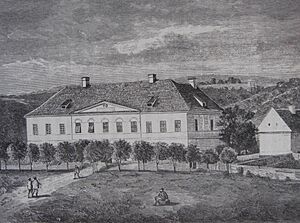
On March 15, 1848, a group of young artists and scholars published a reform plan. This was from the radical delegates of the Diet of Hungary. It was done without official permission in Buda (Hungary's capital). Six days later, radical citizens and students in Kolozsvár accepted a similar plan. It also demanded solutions for the Székely people's problems. Soon, the assemblies of the Székely seats replaced the Conservative royal judges with Liberal politicians.
The Diet of Transylvania, mostly Hungarian delegates, voted to unite Transylvania and Hungary on May 30. The Diet also ended serfdom on June 6. The new law gave land even to landless workers (cotters). But it excluded those who settled on "Székely inheritance" lands. This was because dividing the free Székelys' properties would create thousands of tiny plots. These would be too small to live on. The population of Székely Land had doubled between 1767 and 1846. But the amount of farmland could not increase. Zsigmond Perényi (appointed by the Diet of Hungary to study the problem) suggested settling landless Székely peasants in Banat.
Lajos Batthyány, Prime Minister of Hungary, urged the Székelys to fight for the revolutionary government. Soon, three Székely battalions joined the Hungarian army. They fought against Josip Jelačić, Ban of Croatia, who had turned against the Hungarian government. The government ended the Military Frontier. This removed the imperial officials' power over the Székely regiments. Most Romanians and Saxons opposed the union of Transylvania and Hungary. They sided with the royal court, which led to a civil war. Soon, hundreds of Hungarians were killed in the counties.
Batthyány's commissioner, László Berzenczey, called a general assembly of the Székelys to Agyagfalva. He threatened those who didn't attend with death, according to old laws. On October 18, the assembly declared that all Székelys were equal before the law. An army of 30,000 strong was formed. Székely troops looted the Saxon town of Szászrégen (now Reghin in Romania). But the imperial army's cannons forced them to flee from the battlefield at Marosvásárhely. Soon, imperial troops took Marosszék and Udvarhelyszék. But the Székelys of Háromszék resisted until the end of 1848. They stopped General Anton Puchner from helping the imperial army in Hungary. The many cannons that Áron Gábor (a former artillery officer) made during the fights helped their resistance succeed.
By late 1848 and early 1849, Székelys joined the army led by General Józef Bem. They took part in his successful campaigns. These campaigns drove Habsburg troops out of Transylvania. The successful fight was finally crushed when the imperial Russian army entered Transylvania. This happened after the Habsburg Monarchy asked for their help.
Union with Hungary
In 1867, an agreement (Compromise) was made between Austria and Hungary. This created the Dual Monarchy. According to this Compromise, Transylvania was united with the Kingdom of Hungary. Ten years later, a new county system was introduced in the Kingdom. This ended the long tradition of Székely Seats.
See also
- Treaty of Trianon
- Hungarian minority in Romania
- Magyar Autonomous Region
- Avar Khaganate
Images for kids
-
Attila the Hun (from the Illuminated Chronicle): Old stories often linked the Székelys to the Huns.
-
King St. Stephen Chapel in Kézdiszentlélek (now Sânzieni in Romania).
-
Székely Land (in blue) in Transylvania within the medieval Kingdom of Hungary.
-
Gabriel Bethlen (1619) forbade Székelys from choosing serfdom.
-
The Székely nobleman, Kelemen Mikes, who followed Francis II Rákóczi into exile.
-
Headquarters of the Háromszék Assembly in Sepsiszentgyörgy (Romanian: Sfântu Gheorghe) in the 19th century.




